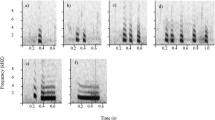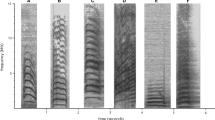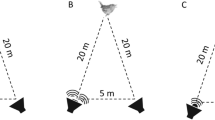Summary
Birds of ten species with similar short flight distances from a human intruder associated with stonechats (Saxicola torquata), which have large flight and alarm call distances. The attendants probably took advantage of the ‘domain of safety’ around the stonechat, produced by the difference in flight distance. Stonechats have no reciprocal advantage, and were not seen to initiate flocks.
Flocks were formed with both calling and silent stonechats. Benefits in the latter case probably include early warning of danger, but there may also have been a reduction in vigilance by attendants.
The relative flocking activity of attendant species (number of associations observed; percentage of incidents with silent stonechats; rate of warning calls by stonechats joined) was related to the species' average flight distance from an intruder (Fig. 1). Possible explanations are consistent with a correspondence between flocking tendency and the degree of benefit obtained.
Similar content being viewed by others
References
Abramson M (1979) Vigilance as a factor influencing flock formation among curlew Numenius arquata. Ibis 121:213–216
Bertram BCR (1978) Living in groups: predators and prey. In: Krebs JR, Davies NB (eds) Behavioural ecology: an evolutionary approach. Blackwell, Oxford, pp 64–96
Caraco T (1979a) Time budgeting and group size: a theory. Ecology 60:611–617
Caraco T (1979b) Time budgeting and group size: a test of theory. Ecology 60:618–627
Greig-Smith PW (1980) Parental investment in nest-defence by stonechats (Saxicola torquata). Anim Behav 28:604–619
Hamilton WD (1971) Geometry for the selfish herd. J Theor Biol 31:295–311
Harpum J (1978) Species-pair association of stonechat and Blacklored Cisticola in southwest Tanzania. Scopus 2:99–101
Lazarus J (1972) Natural selection and the functions of flocking in birds: a reply to Murton. Ibis 114:556–558
Lazarus J (1979) The early warning function of flocking in birds: an experimental study with captive quelea. Anim Behav 27:855–865
Morse DH (1977) Feeding behaviour and predator avoidance in heterospecific groups. Bioscience 27:332–338
Neill SRStJ, Cullen JM (1974) Experiments on whether schooling by their prey affects the hunting behaviour of cephalopods and fish predators. J Zool 172:549–569
Newton I (1972) Finches. Collins, London
Powell GVN (1974) Experimental analysis of the social value of flocking by starlings (Sturnus vulgaris) in relation to predation and foraging. Anim Behav 22:501–505
Pulliam HR (1973) On the advantages of flocking. J Theor Biol 38:419–422
Silliman J, Mills GS, Alden S (1977) Effect of flock size on foraging activity in wintering sanderlings. Wilson Bull 89:434–438
Tallowin J, Youngman RE (1978) Dartford Warbler associating with Stonechat. Br Birds 71:182–183
Author information
Authors and Affiliations
Rights and permissions
About this article
Cite this article
Greig-Smith, P.W. The role of alarm responses in the formation of mixed-species flocks of heathland birds. Behav Ecol Sociobiol 8, 7–10 (1981). https://doi.org/10.1007/BF00302839
Received:
Accepted:
Issue Date:
DOI: https://doi.org/10.1007/BF00302839




